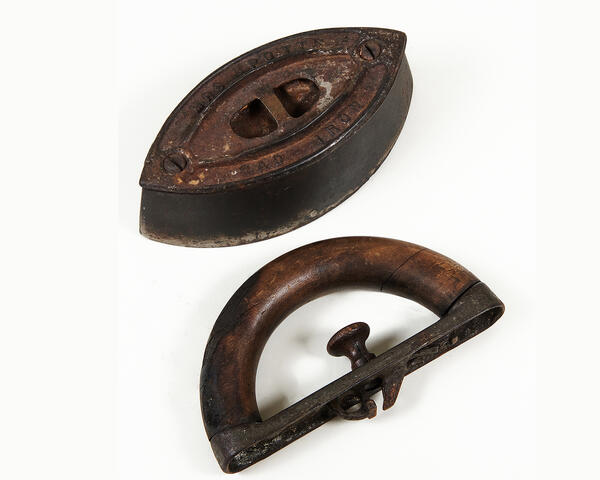The stove-heated iron with a detachable handle from the museum collection is made of cast iron. It appeared in the exhibition thanks to the collector Nikolai Polyakov, the head of the local government in Gorodets. These irons were heated on an open fire or a stove, and later on gas stoves. Hence the name of the iron — stove-heated.
The products were quite heavy; sometimes their weight was up to 12 kilograms. The metal handle, which was heated together with the iron, was not very convenient as well. Therefore, over time, the design had to be omproved. Irons began to be made in pairs: while one was used for ironing, the other was heated on the stove. They shared a detachable handle. Usually, it was either put into an iron, like a belt through the loops of the pants, or fixed like a clothespin. These innovations have significantly simplified everyday life and made the ironing process continuous and much safer.
The irons themselves were a rather expensive thing. They were often passed on from a mother to a daughter. Having an own iron in the house was considered a symbol of prosperity and well-being. Sometimes it was even displayed as a decoration on a napkin next to the samovar (boiling tank). Therefore, many blacksmiths creatively approached the production of irons — often the product was turned into a real work of art. For example, there were irons in the form of a dolphin or a ship.
The simplest irons were cast from cast iron, and the more expensive ones were made of bronze, which was inlaid with copper or silver. Irons' handles, in order not to be overheated, as a rule, were made of wood, as in the case of the iron from the museum. The iron made of metal was inconvenient for the woman also because it caused an interruption in work: to heat the iron it had to be put periodically on the stove. Detachable handle also solved this problem.
The history of iron modernization is closely connected with the name of the inventor Mary Florence Potts. In 1870, as a 19-year-old girl, she received her first patent for a metal iron, both ends of which were pointed. Potts pointed out that such modification made the ironing more convenient in both directions. A year later, she patented an iron with a detachable handle, which made it possible to heat the sole of the iron without burning oneself. The design turned out to be very convenient, and in the future, many manufacturers around the world used it.
There was only one small drawback: the heated metal sole of the iron cooled down very quickly. Therefore, Mary Potts, who started selling her iron, began to complete it with three soles and one handle. This invention of hers became one of the most significant in the history of the 19th century.
The products were quite heavy; sometimes their weight was up to 12 kilograms. The metal handle, which was heated together with the iron, was not very convenient as well. Therefore, over time, the design had to be omproved. Irons began to be made in pairs: while one was used for ironing, the other was heated on the stove. They shared a detachable handle. Usually, it was either put into an iron, like a belt through the loops of the pants, or fixed like a clothespin. These innovations have significantly simplified everyday life and made the ironing process continuous and much safer.
The irons themselves were a rather expensive thing. They were often passed on from a mother to a daughter. Having an own iron in the house was considered a symbol of prosperity and well-being. Sometimes it was even displayed as a decoration on a napkin next to the samovar (boiling tank). Therefore, many blacksmiths creatively approached the production of irons — often the product was turned into a real work of art. For example, there were irons in the form of a dolphin or a ship.
The simplest irons were cast from cast iron, and the more expensive ones were made of bronze, which was inlaid with copper or silver. Irons' handles, in order not to be overheated, as a rule, were made of wood, as in the case of the iron from the museum. The iron made of metal was inconvenient for the woman also because it caused an interruption in work: to heat the iron it had to be put periodically on the stove. Detachable handle also solved this problem.
The history of iron modernization is closely connected with the name of the inventor Mary Florence Potts. In 1870, as a 19-year-old girl, she received her first patent for a metal iron, both ends of which were pointed. Potts pointed out that such modification made the ironing more convenient in both directions. A year later, she patented an iron with a detachable handle, which made it possible to heat the sole of the iron without burning oneself. The design turned out to be very convenient, and in the future, many manufacturers around the world used it.
There was only one small drawback: the heated metal sole of the iron cooled down very quickly. Therefore, Mary Potts, who started selling her iron, began to complete it with three soles and one handle. This invention of hers became one of the most significant in the history of the 19th century.



